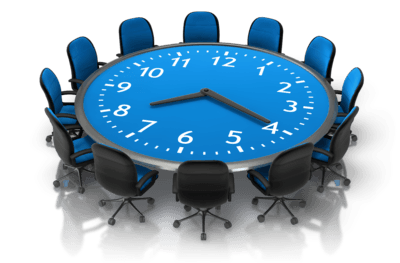Project meetings can be maddening. Some people come unprepared. Others get off track. And how about those that constantly check email. Let's improve your meetings through project meeting roles.

Team members leave meetings with no decisions, lacking direction, and not knowing what to expect next. Power-hungry individuals dominate the discussions. The meek say nothing.
Meetings can be an absolute waste of time and money.
How can we better manage our meetings and get results? Assign meeting roles that combat common meeting problems.
More...
Project Meeting Roles
Facilitator
The facilitator begins each meeting by stating the purpose of the meeting, reviewing the agenda items, and acknowledging meeting role assignments.
Then the facilitator starts with the first agenda item. He or she engages the participants ensuring everyone has the opportunity to contribute.
Furthermore, facilitators should summarize the outcome for each agenda item before moving to the next item. This allows the team to validate the summary. Additionally, it allows the scribe to capture the appropriate information.
At the end of the meeting, review the key decisions, action items, issues, and next steps.
Scribe
One of the least appreciated but most important roles is the scribe. The scribe has a challenging position. A scribe needs to be able to listen, summarize, and capture the essential elements for the project meeting minutes.
Gatekeeper
The gatekeeper keeps the meeting participants on track. When individuals drift off topic, the gatekeeper brings them back to the current agenda item.
If the team members identify an item that merits further discussion, the facilitator asks the scribe to capture the item in the Parking Lot.
Timekeeper
The facilitator should designate the amount of time for each agenda item. The timekeeper monitors the time.
Periodically the timekeeper reminds everyone of the time remaining such as “There are five minutes remaining.” A little later, “There are two minutes remaining” and finally, “Time’s up.”

Coach
The coach role is rarely used, but can be extremely helpful. The coach has the responsibility of making observations about the meeting.
- What was the interaction like between the team members?
- How well did the members complete the agenda items with desired outcomes?
- Did participants stay on track and fulfill the purpose of the meeting?
At the end of the meeting, the facilitator asks the coach to take 2-3 minutes to present his or her observations.
Furthermore, the coach should focus on the meeting process, not on the individuals. Be graceful and encouraging, but don’t shy away from making the appropriate comments.
Make Your Project Meetings Marvelous (Okay, at least good)
Engage and educate your stakeholders. Leverage the coach’s feedback. Use your leadership skills to influence good behavior.
How many roles do you need? For a meeting with 3-4 people, you may only need a facilitator and a scribe. For a meeting with 10 or more people, you may wish to utilize all of these roles.
Lastly, educate your team members on meeting roles. Consider sharing this blog post. Assign roles where appropriate, evaluate the results, and help the team to mature.
Project Risk Coach Tips

Sign up for the weekly Project Risk Coach blog posts and receive the Project Management Plan Checklist. This will allow you to deliver projects with fewer problems and greater value.
"Intelligent leadership, creative communication and depth of technical skill all describe Harry Hall." –John Bartuska, Director of HR–ONUG Communications
